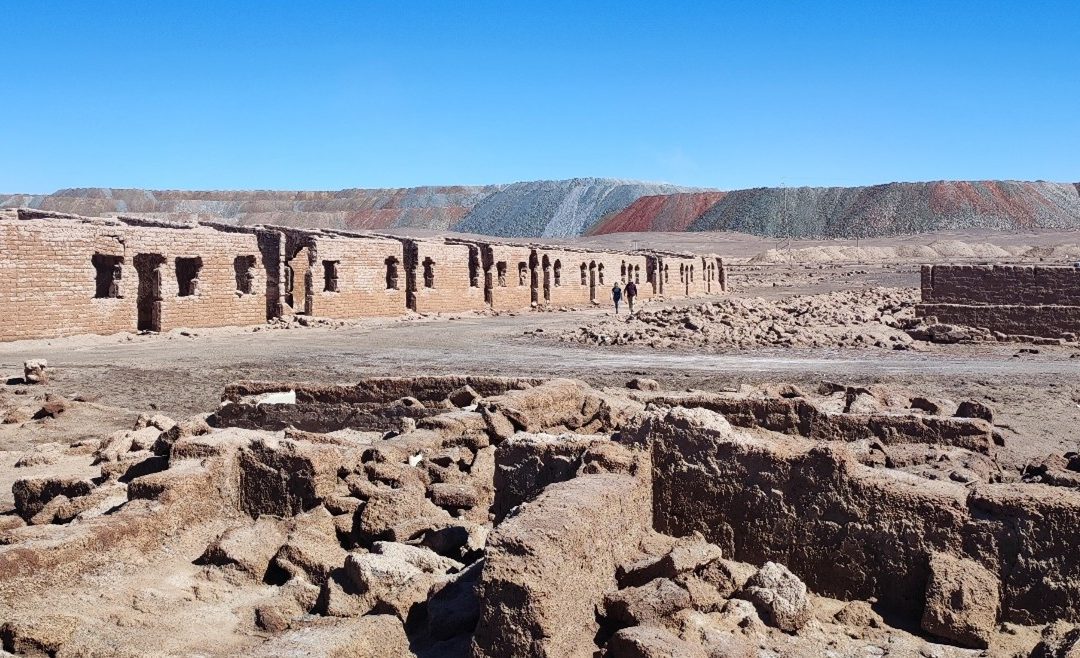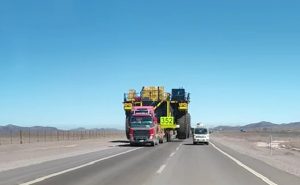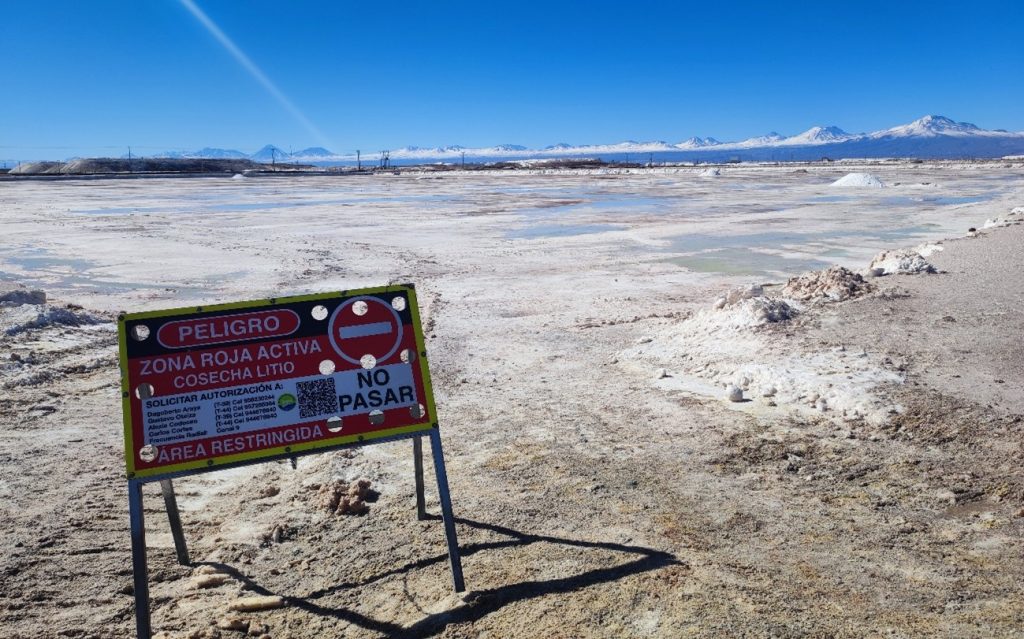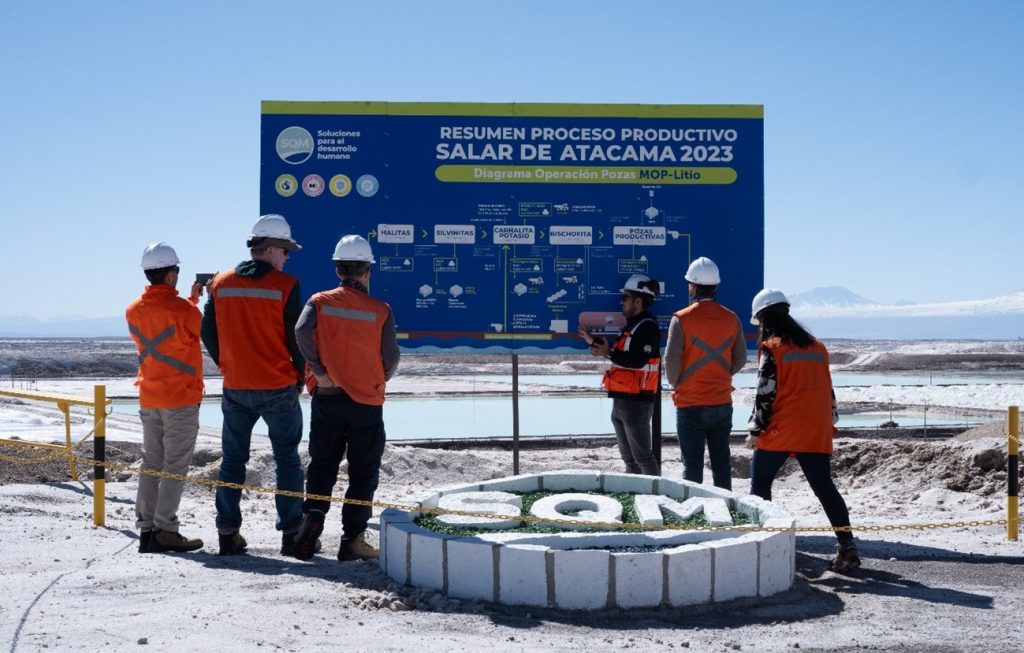Remains of the Pampa Lina saltpetre offices (foreground) beside modern mining waste (background). Photo: Esteban Valle Riestra
By Esteban Valle Riestra, Postgraduate researcher, GDI
The Atacama Desert in Chile may appear to be a barren and unproductive land, where the endless arid terrain, the scorching sun, and the near absence of rain would make life impossible. “Silence, dust and oblivion” reads the epitaph on a tombstone in one of its cemeteries – nouns that capture the essence of this territory. Yet, these words conceal the fact that the Atacama Desert has played a crucial role in shaping major economic and political transformations at a planetary scale, many of which cannot be understood without acknowledging its contribution. Silver bars from Potosí used to descend on muleback across this territory. Sacks of guano and saltpetre nitrates were extracted and shipped off to fertilise European fields. The world’s largest open-pit copper mine used to operate in this region, and today, a significant portion of the lithium crucial for the energy transition is produced in this very place.
In July 2025, I had the opportunity to travel across the Atacama Desert from west to east, from the Pacific Ocean to the Andes mountains, tracing the footprints left by successive commodity booms that have shaped global history. I undertook this journey with a multidisciplinary group of researchers from Chile, Colombia and the United States[1] under the auspice of a Ford-LASA Special Project aimed at supporting our collective exploration of the material and symbolic legacies of extraction in South America.
On our four-day journey, we explored sites of extraction historically tied to global trade networks, beginning in the colonial period and continuing into the present. Along the coast, our Chilean colleagues drove us near the site where the port of Cobija once stood, a place from which silver coins, produced through Indigenous labour in present-day Bolivia, were dispatched to Spain. Today, only ruins remain of what was once a key geographic node sustaining the expansion of the first global empire in the 16th century.
Further inland, we passed by the remnants of saltpetre operations, a commodity that played an essential role in the early days of the Industrial Revolution by enhancing agricultural productivity and thus helping to feed the growing ranks of the emerging proletariat. We walked through the ruins of Pampa Lina, a former company town where raw saltpetre was processed using technology imported from the British Isles until the mid-20th century. Hundreds of workers and their families once lived and laboured there. Today, the site stands abandoned, with piles of mining waste from modern operations just metres away.
As we ascended towards the city of Calama, we travelled alongside the electric transmission lines that power the Chuquicamata mine, accompanied by dozens of trucks loaded with chemical supplies heading in the same direction. This open-pit mine, once controlled by the North American company Anaconda, used to account for a significant portion of the world’s copper supply. Today, under the administration of the state-run company CODELCO since its nationalisation in 1971, the mine remains operational and continues to expand, gradually overtaking the areas that once housed its workforce.
We also observed clear signs of the current boom in renewable energy and lithium. Along the highway, massive solar farms and wind turbines emerged in a seemingly endless sequence, accompanied by converter substations linking the energy to industrial operations. And at the foothills of the Andes, in the Salar de Atacama, we toured the facilities of the Chilean private company SQM, which harvests and process nearly one-fifth of the world’s lithium carbonate used in electric vehicles and smartphones.
What endures? What fades?
Despite the hectic pace of the trip, we found moments to pause and reflect on the legacies of extraction we encountered along the way. Travelling through this territory made us think that if modernity was built upon colonial relations and an unequal exchange of primary goods between the centre and the periphery, as Latin American critical theory suggests, then this territory was – and remains to this day – one of its cornerstones. However, our observations raised a deeper set of questions about what endures and what slowly disappears after each extractive cycle. Are silence, dust, and oblivion all that remains? As in archaeological studies, we were able to observe overlapping material layers, each tied to a distinct era. But did each commodity boom simply exhaust itself and then fade out, leaving no more than a few material traces behind? Or were new extractive regimes built on top old ones, evolving through technological innovations and changing managerial practices?
At first, we shared the impression that each extractive cycle –from silver to renewable energy– was similar in essence: a resource drawn from the Atacama Desert due to its singular climatic and geological conditions, or moved through it thanks to its strategic location few kilometres away from the Pacific Ocean. Even though the commodities changed, the structural logic of resource extraction remained the same. Each time, this territory had to be reshaped and its inhabitants disciplined to ensure the uninterrupted flow of commodities to the global markets, following the guidelines and instructions set in distant financial and colonial capitals -Madrid, London, Hamburg, New York. Imported technologies were deployed, then grew in scale and efficiency, enabling greater productivity at lower cost, while simultaneously producing profound transformations: pollution, overexploitation, social conflicts and large-scale movement of people and inputs.
Yet the distinct character of each commodity boom was also plainly visible. In our conversations, we kept returning to the striking overlaps between old and new infrastructures. These were tangible expressions of both the reach and the limits of the technological horizons and knowledge systems underpinning each era. Although some infrastructures were being repurposed, decommissioned coal-powered plants stood beside sprawling renewable energy farms; old railway lines ran in parallel to modern highways; towns once inhabited were now giving way to modular camps designed for rotational labour. Far from an ode to human ingenuity, these contrasts did not speak of linear progress, but of an expanding scale of extraction. Moreover, the accumulation of waste, from abandoned saltpetre factories to the millions of tons of contemporary mining residuals, and the proximity of toxic sites to modern cities like Calama and Tocopilla, close enough for residues to cause serious harm to thousands of residents, offered stark evidence of the accumulative ecological footprint of our civilization’s hunger for raw materials.
Extractive legacies
During this journey, extractivism became a key theme in our collective discussions. This term is often used in Latin American academia to describe a development model based on the extraction of raw materials in large volumes, with minimal processing, primarily destined for export to industrialised countries. This model has been established and consolidated with the complicity of states, which have enabled small groups to control vast resources through legal instruments and – as is often the case – violence. Extractivism generates in turn multiple ‘spillover effects’: it reproduces colonial centre-periphery relations, an international and gendered division of labour, deepens inequalities in access to justice, undermines democracy, leads to severe environmental impacts, and draws a dividing line between oppressors and the oppressed.
Extractivism is often held accountable for transforming landscapes into ‘sacrifice zones’ and leaving behind toxic legacies as indelible marks. Yet, we soon realized that while extractivism serves as a functional category to mobilise resistance against extractive activities, it offers limited insight into how this development model shapes territories over time, produces subjectivities, and gives rise to symbolic legacies and topographies that enable the ongoing reproduction of extraction. Portraying extractivism solely as a destructive force falls short of capturing the complexities present in regions shaped by overlapping extractive cycles, such as the Atacama Desert.
New extractive waves do not occur on a void, they are rather built upon the symbolic and material legacies of those that preceded them, which define in turn their scope and limits. In that vein, drawing on our collective insights, my colleague Javiera Madrid-Salazar prompted us to consider that the legacies of extractive activities operate on multiple scales.
First, the scale of the body and mind. Each extractive cycle, brief from the perspective of capital, can leave profound marks at the scale of human lifetimes. Their legacy is often inscribed in the lungs, blood, and skin of workers as a result of harsh labour conditions: long shifts, the continuous exposure to chemical materials, and prolonged use of heavy machinery. These conditions led many to live short lives, shaped by accidents and illness, or compelled workers to organise and demand better working arrangements at a great personal cost and often under threat of violence and retaliation. At the same time, legacies are inscribed in memories, in recollections of experiences and anecdotes, often recalled with nostalgia and preserved through tales, songs, photographs, and written records. Legacies at this scale not only speaks of suffering but also feeds into heroic narratives of endurance and resistance, passed down through generations and embedded in collective identities, perceptions and attitudes towards extractive activities.
Second, within the territory itself. At both large and small scales, extractive activities rely on the deployment of technologies and infrastructures necessary to enable extraction. Each extractive cycle has hinged upon the efforts of naturalists, geologists and prospectors to determine the abundance of natural resources and the economic feasibility of their exploitation. Their contributions have been fundamental in making resources visible, legible, and calculable for commercial purposes, as well as in reproducing a colonial vision and western rationality over the territory. These processes are followed by the reconfiguration of both the natural environment and the social fabric through land enclosure, deforestation, diversion of watercourses, resettlement and more. However, even as they transform natural endowments into commodities and then reorganise the landscape and modes of inhabiting it, extractive activities also produce territories. They lead to the construction of infrastructure—roads, railways, highways—to move materials and supplies to extraction sites, and the development of enclaves – company towns, cities, camps – that grow and evolve over time. Likewise, they provide the basis for a standardised and instrumental portrayal of the territory, useful to governmental actors for purposes of planning, control, and resource management. New extractive booms build upon these inherited knowledges and topographies.
Taken together, these legacies shape the contours of symbolic imaginaries and leave a lasting imprint the governance of natural resources. The impacts of each commodities boom on bodies and territories give rise to memories, attitudes, and perceptions that shape social imaginaries about extraction at local, national, and even global scales. Moreover, the experience of each commodity cycle brings about new debates regarding who should have access to natural resources, how they should be extracted, and which groups should benefit or be compensated. These legacies also underpin institutions, normative frameworks, and practices that enable or constrain the scope of resource governance today, reinforcing patterns of spatial organisation and territorial imaginaries rooted in previous cycles of extraction. The Atacama Desert offered several illustrations of this dynamic. The prevailing imaginary of the region as a resource-rich space, ready to supply global demand, stems from its long extractive history and continues to shape how the territory is perceived and valued.
New and old questions
Engaging with these legacies not only helped us better understand the nuances between different forms of extractivism during this trip, but also shed light on the terms in which extractive activities transform territories’ social, economic and cultural constitution. In my case, it led me to believe that reflecting about the legacies – on the body, the territory, and symbolic imaginaries – can bring depth to fundamental questions in the field of natural resource governance: Why do some groups oppose extraction while others welcome it? Why are certain territories organized in a way that predisposes them to attract new investments, while others are left dealing with abandoned infrastructure? Why do some states intervene actively in the extraction process, while others prefer to hand over their resources to the market forces?
In the Atacama Desert, extraction is grounded in accumulated experience, in pre-existing infrastructures, and in long-lasting symbolic legacies. They days of silver and saltpetre are long gone. Today, it is the rush for copper, lithium and renewable energy that drives the movement of people and capital. One only had to look around to see the thousands of workers coming and going, in airports and along highways, demanding services and, despite the relentless sun and the pollution, entering into these dynamics with a sense of belonging to something greater and essential. Although they no longer work under the same conditions as their predecessors – now, they receive salaries well above the national average, but under intensive shift systems such as 7-days-on and 7-days-off – the work continues to impose new demands on their lives and produce new transformations in the territory.
It was not only silence, dust and oblivion. It was also noise, materiality and memory.
[1] Matthew Himley (USA), Damir Galaz-Mandakovi (Chile), Manuel Méndez (Chile), Javiera Madrid-Salazar (Chile), Daniela Mosquera-Camacho (Colombia), Lorena Campuzano (Colombia), Pablo Jaramillo (Colombia).
Note: This article gives the views of the author/academic featured and does not necessarily represent the views of the Global Development Institute as a whole.
Please feel free to use this post under the following Creative Commons license: Attribution-NonCommercial-NoDerivatives 4.0 International (CC BY-NC-ND 4.0). Full information is available here.





